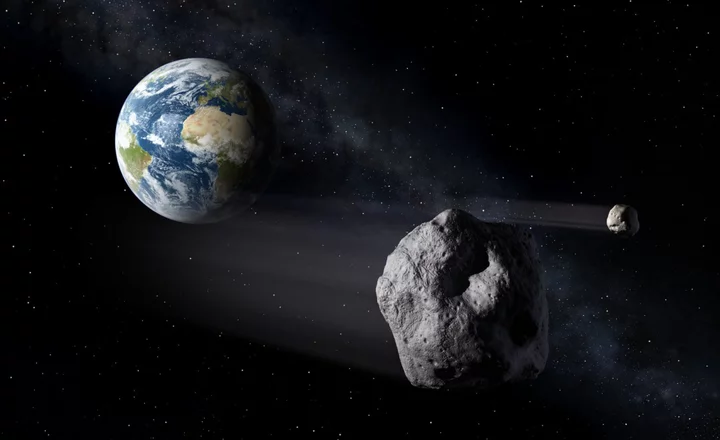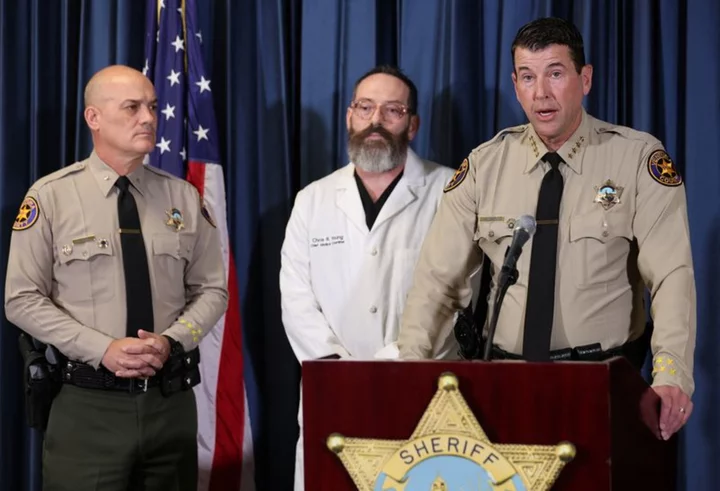Off the baking Interstate 40 in Arizona, the evidence is clear: From time to time, sizable asteroids do pummel Earth.
There, you'll find the 600-foot-deep "Meteor Crater," which landed 50,000 years ago. The culprit was likely some 100 to 170 feet across, creating a blast big enough to destroy Kansas City. While the space rock wasn't small, it wasn't nearly a "planet-killer" like the roughly six-mile-wide behemoth that wiped out most dinosaurs.
Though the threat of another significant collision — whether from an asteroid 200 feet or 2,000 feet across — is inevitable, scientists have optimistic news to report. A new census of many of the largest asteroids that pass through our solar system neighborhood confirmed there's no known threat of collision for the next century, and the likelihood of an impact in the next thousand years is exceedingly low — though there are around 20 huge cosmic rocks researchers will keep tabs on, because their distant future trajectories aren't yet certain.
Crucially, there's no alarm about these particular asteroids, which are a kilometer (0.6 miles) wide or even larger. But the new research underscored that a thousand years into the future some trajectories remain unsettled, and more observation is needed to completely rule out a potential impact.
"We need more information about these asteroids, although the probability [for an impact] is still very low," Oscar Fuentes-Muñoz, a researcher at the University of Colorado Boulder who led the new census, told Mashable.
SEE ALSO: Scientists find 'planet-killer' asteroids lurking in an elusive placeThis planetary defense research, currently posted on the research-sharing platform arxiv, will be published in The Astronomical Journal, a peer-reviewed publication.
The striking Meteor Crater in Arizona. Credit: Stephan Hoerold / Getty ImagesWhy the threat of an asteroid collision is low
NASA and other scientists are vigilantly watching the skies for "near-Earth objects," also commonly called "near-Earth asteroids."
Astronomers have found nearly 10,000 nearby space rocks ("nearby" often means many millions of miles away) that span over 460 feet across, as of May 2023, with some 500 more such objects sleuthed from the dark skies each year. These have the potential to cause vast regional destruction, and an estimated 15,000 remain undiscovered. Fortunately, over 90 percent of the largest behemoths — over a half-mile across — have been found.
A graph showing near-Earth asteroid discoveries. Discoveries have ramped up since the early 2000s. Credit: NASA / Center for Near Earth Object StudiesFuture impact risk remains low, however, for two reasons: The evidence we have about the frequency of asteroids that hit Earth today and in the past, along with no proof of any known looming asteroid strikes. (Asteroid-sleuthing telescopes are trained on the skies each night.)
Impressively, every single day about 100 tons of dust and sand-sized particles fall through Earth's atmosphere and promptly burn up. Every year, on average, an "automobile-sized asteroid" plummets through our sky and explodes, explains NASA. Impacts by objects around 460 feet in diameter occur every 10,000 to 20,000 years, and a "dinosaur-killing" impact from a rock perhaps a half-mile across or larger happens on 100-million-year timescales.
In short, the chances of a major impact in our lifetimes is, as far as we know, extremely small, astronomers say.
This latest census looked at 851 giant asteroids whose orbits at times pass through Earth's neighborhood, and who spend a longer time near us. Though they pose no threat in the next century, the researchers endeavored to see what the asteroids might do farther out, in a thousand years, after they're affected by the gravity of other planets and scorching heat from the sun. They ran new simulations of the asteroids' orbits, and found most pose no threat. But some 20 asteroids, whose orbits around the sun aren't as certain, didn't prove as predictable. More observation is necessary.
For example, simulations of the asteroid 7482 (1994 PC1), which is two-thirds of a mile long, showed the rock passed through Earth's orbit around the sun (though not Earth) multiple times over the next thousand years. For now, 7482 (1994 PC1)'s impact risk can't be ruled out.
Want more science and tech news delivered straight to your inbox? Sign up for Mashable's Light Speed newsletter today
How scientists find nearby asteroids
Sky surveys, as noted above, are regularly finding new asteroids. There's the NASA-funded Panoramic Survey Telescope and Rapid Response System (Pan-STARRS) atop Maui, the Catalina Sky Survey in Arizona's Santa Catalina Mountains, and the Asteroid Terrestrial-impact Last Alert System (ATLAS) with telescopes around the world, among other asteroid-watching programs.
The surveys can provide crucial information about a potential strike and how it would affect Earth and its denizens. For example, would people in a certain region need to shelter indoors away from glass windows if an asteroid were expected to explode in the atmosphere? (For reference, see the Chelyabinsk meteor event.)
"You need to know what's coming, when it's coming, and how hard it's going to hit," Eric Christensen, the director of the NEO-seeking Catalina Sky Survey in Arizona, told Mashable last year.
A visualization showing hundreds of near-Earth asteroids in our solar system (blue dots). Earth's orbit around the sun is also shown in blue. Credit: NASA / JPL-CaltechWhat's more, giant new telescopes, like the Vera C. Rubin Observatory, located over 8,700 feet up in Chile's Cerro Pachón ridge, will soon come online and take inventory of millions of solar system objects, including new rocks that at times swing near Earth.
"We're doing our due diligence to completely find them."It's not easy to find new points of moving light in our crowded solar system. But scientists are identifying these potential threats. "We're doing our job," said Fuentes-Muñoz. "We're doing our due diligence to completely find them."
And when we do find any that might veer toward Earth, we likely won't be helpless. The plan is to divert such an asteroid's trajectory. In an unprecedented September 2022 achievement, NASA's DART mission successfully crashed a refrigerator-sized spacecraft into the asteroid Dimorphos (which was not a threat to Earth) in an effort to prove that humanity could alter the path of an incoming space rock, should this effort become necessary.
Today, we don't have the capability to readily deploy an asteroid-deflecting endeavor. But if the relentless march of technology is any hint, we might be well-equipped to deal with an imminent asteroid threat a century or so from now, if not sooner.
"You expect we'll be a lot farther along," Fuentes-Muñoz said.









